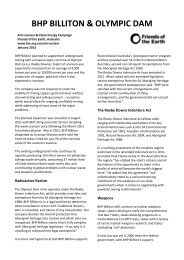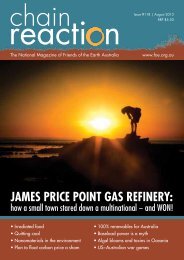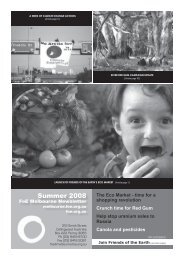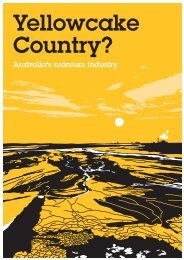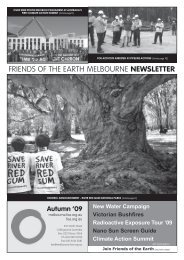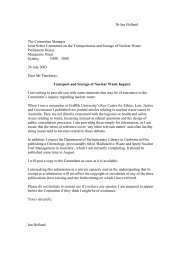Thirty Years of Creative Resistance - Friends of the Earth Australia
Thirty Years of Creative Resistance - Friends of the Earth Australia
Thirty Years of Creative Resistance - Friends of the Earth Australia
Create successful ePaper yourself
Turn your PDF publications into a flip-book with our unique Google optimized e-Paper software.
This critical approach was not appreciated<br />
by all green groups, but over <strong>the</strong> years<br />
<strong>the</strong>se same groups came to support FoE’s<br />
position, resulting in a more sophisticated<br />
and holistic position on timber production<br />
being adopted by much <strong>of</strong> <strong>the</strong> movement.<br />
FoE also started to raise awareness <strong>of</strong> <strong>the</strong><br />
threats posed by Copper Chrome Arsenate<br />
(CCA), <strong>the</strong> most common treatment for<br />
preserving s<strong>of</strong>twood timber. After several<br />
years this started to yield results as <strong>the</strong><br />
issue was finally taken seriously by o<strong>the</strong>r<br />
green groups, <strong>the</strong> broader community and<br />
relevant authorities. In 2003, <strong>the</strong> <strong>Australia</strong>n<br />
Pesticides and Veterinary Medical<br />
Authority announced that it intended to<br />
place a ban on <strong>the</strong> use <strong>of</strong> CCA in certain<br />
domestic situations because <strong>of</strong> heath risks.<br />
In August 1991, <strong>the</strong> bulk chemical<br />
facility at Coode Island in inner western<br />
Melbourne suffered a major fire and a<br />
toxic cloud descended over much <strong>of</strong> <strong>the</strong><br />
city. An inquiry was held into <strong>the</strong> possible<br />
relocation <strong>of</strong> <strong>the</strong> facility to Point Lillias,<br />
a headland on Port Phillip Bay near<br />
Geelong. The situation was complicated<br />
by plans to locate a naval arms complex<br />
on <strong>the</strong> same headland, <strong>the</strong> East Coast<br />
Armaments Complex. FoEM worked with<br />
a range <strong>of</strong> o<strong>the</strong>r groups throughout <strong>the</strong><br />
parallel state and federal inquiries into<br />
<strong>the</strong> re-location <strong>of</strong> <strong>the</strong>se facilities under<br />
<strong>the</strong> banner <strong>of</strong> <strong>the</strong> Combined Environment<br />
Groups. FoEM argued that any decision<br />
on <strong>the</strong> Coode facility should occur within<br />
In 1992, FoE Fitzroy launched its forest<br />
campaign.<br />
...................................................................................................................................................................................................<br />
FoE maintained a regular picket outside <strong>the</strong> state government<br />
department responsible for logging (DNRE).<br />
a context that sought to achieve an<br />
overall reduction in <strong>the</strong> use <strong>of</strong> hazardous<br />
chemicals. In <strong>the</strong> end, nei<strong>the</strong>r facility was<br />
moved to Point Lillias. The Coode Island<br />
facility remains a danger to residents<br />
in <strong>the</strong> inner west suburbs <strong>of</strong> Melbourne<br />
and FoEM continues to work to highlight<br />
<strong>the</strong> costs and impacts <strong>of</strong> our chemical<br />
dependence.<br />
Clare Henderson and Larry O’Loughlan<br />
were prominent national advocates <strong>of</strong><br />
Right To Know (RTK) legislation in <strong>the</strong><br />
early 1990s. RTK refers to <strong>the</strong> right <strong>of</strong><br />
people to access information on <strong>the</strong><br />
existence, quantities and effects <strong>of</strong><br />
emissions from industrial activities. The<br />
call for RTK legislation was occurring<br />
against a backdrop <strong>of</strong> voluntary programs<br />
such as <strong>the</strong> ‘responsible care’ program<br />
initiated by <strong>the</strong> <strong>Australia</strong>n Chemical<br />
Industry Council and was based on <strong>the</strong><br />
correct assumption that large companies<br />
could not be trusted to manage <strong>the</strong>ir<br />
operations through voluntary disclosure<br />
programs.<br />
FoEM began working on forest issues in<br />
1992, when <strong>the</strong> East Gippsland Forest<br />
Network (EGFN) merged with FoEM. The<br />
EGFN had itself grown from Melbourne<br />
Rainforest Action Group in <strong>the</strong> late 1980s.<br />
The creation <strong>of</strong> <strong>the</strong> FoEM Forest Network<br />
and <strong>the</strong> energy <strong>of</strong> a new generation <strong>of</strong><br />
activists resulted in more than five years <strong>of</strong><br />
intense campaigning to protect Victoria’s<br />
forests. Over <strong>the</strong> summer <strong>of</strong> 1993-94,<br />
FoEM joined <strong>the</strong> Wilderness Society and<br />
Concerned Residents <strong>of</strong> East Gippsland to<br />
form <strong>the</strong> East Gippsland Forest Alliance.<br />
FoE 30 <strong>Years</strong> 55



